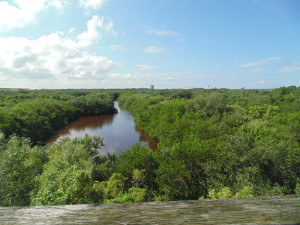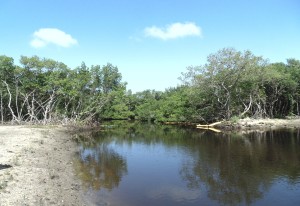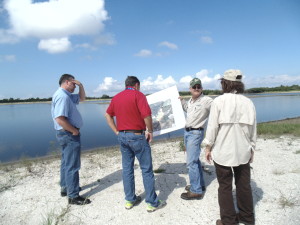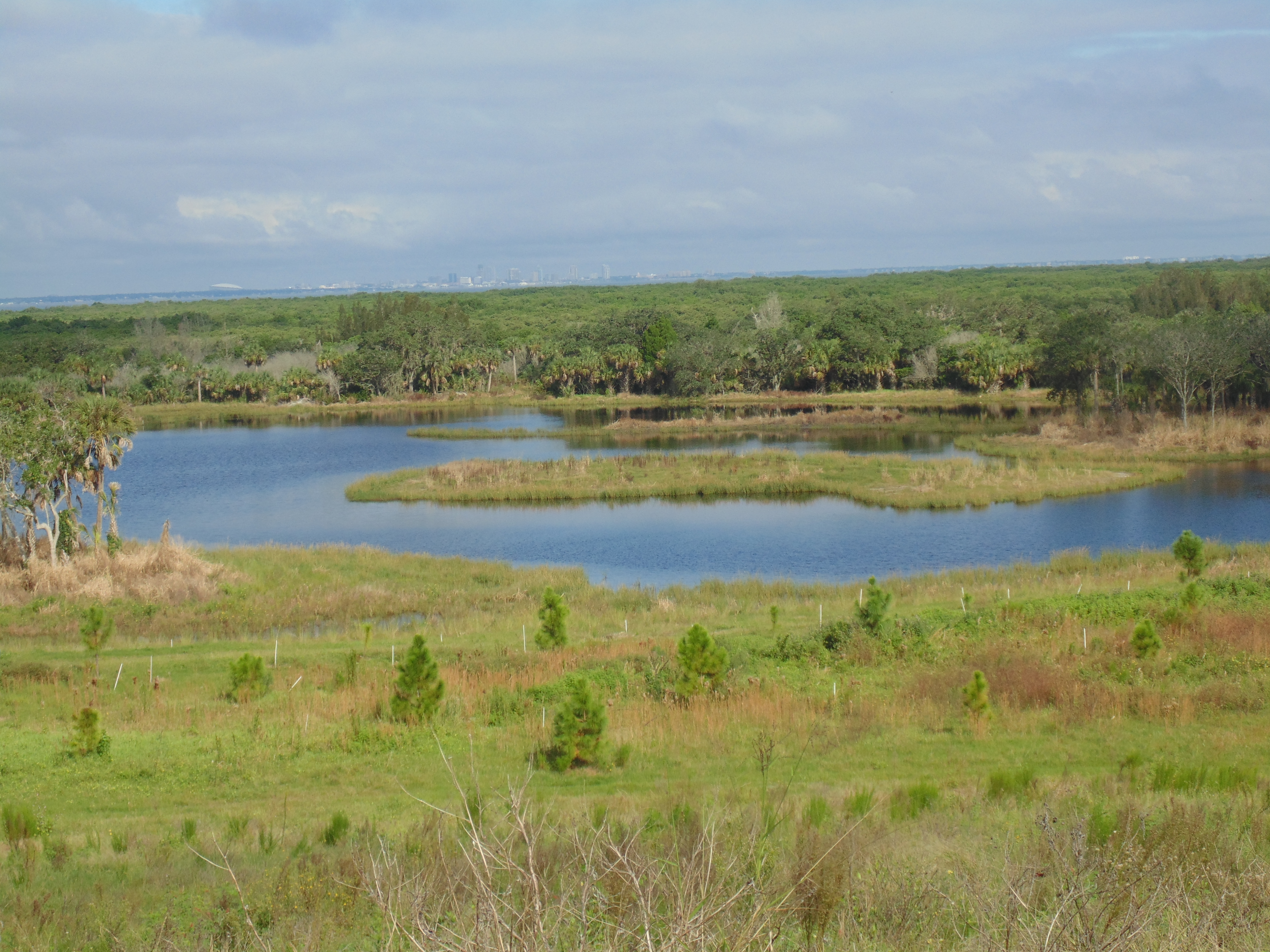More than 400 volunteers are expected to set a record for planting marsh grasses at the single largest parcel in a 20-mile stretch of restored coastal ecosystems along Tampa Bay’s eastern shore. The event begins at 9 a.m. on Saturday, Nov. 14 at Rock Ponds, located just north of the Manatee County line and south of Cockroach Bay.
 Named for the borrow pits scattered across the site, the 2,543-acre parcel was jointly purchased by Hillsborough County and the Southwest Florida Water Management District in 2004. “It’s the largest restoration project on coastal Tampa Bay – and it’s likely to stay that way,” says Brandt Henningsen, chief environmental scientist for the district’s Surface Water Improvement and Management (SWIM) program. “There’s not another piece of land this size still available along the bay.”
Named for the borrow pits scattered across the site, the 2,543-acre parcel was jointly purchased by Hillsborough County and the Southwest Florida Water Management District in 2004. “It’s the largest restoration project on coastal Tampa Bay – and it’s likely to stay that way,” says Brandt Henningsen, chief environmental scientist for the district’s Surface Water Improvement and Management (SWIM) program. “There’s not another piece of land this size still available along the bay.”
Restoration officially began in 2012 on the uplands habitats, although a team including Henningsen, Nancy Norton, SWIM’s engineer, and Scheda Ecological Associates spent nearly two years mapping the parcel, identifying habitat that survived mining and farm operations, and planning a mosaic of habitats.

“We looked carefully at what we could save, including some existing hardwood hammocks and wetlands and identified potential sources for both fresh and saltwater,” Norton said. Borrow pits near the bay were essentially blocked from tidal flow and suffered from algal blooms nearly every summer. The northern pit was so deep that few fish were found, even when it was drained as part of the restoration effort. Other parts of the site were so overgrown with Brazilian pepper, cogon grass or Australian pine that walking through them was practically impossible.
Even so, the shallower pits along the bay had become one of the most important nesting locations for many types of birds in the Tampa Bay region, including reddish egrets, the rarest wading bird in the U.S. The restoration was timed so that it took place only when birds weren’t present, Norton adds.
This is the second year organizers have tried to set a record for salt marsh plantings. Last year, they fell short because too few volunteers were available to harvest the plants from a donor site at Port Manatee. Still, the results of those efforts are amazing. Once-bare shorelines scraped by bulldozers to precise elevations are now covered in lush growth with marsh grasses starting to grow together. Red, white and black mangroves have sprouted from propagules that floated through newly opened tidal channels, and fiddler crabs dance from one hiding spot to another.

With a high point of 17 feet above sea level at U.S. 41, Rock Ponds features multiple habitats, from freshwater lagoons fed by Piney Point Creek that cascade into low-salinity intertidal lagoons that are critical to the life cycles of many fish, including snook and tarpon. It’s also designed to accommodate sea level rise over the next 100 years.
Rock Ponds should be complete in December 2015 and will open to the public when parking facilities and restrooms are finished. In the meantime, kayakers can paddle the new lagoon at the northeast side of the property with access through Cockroach Bay and up Andrews Creek.
“If Rock Ponds is anything like Cockroach Bay, one of the most popular features will be the two overlook ‘mountains’ we were able to build with extra soil from the excavations,” Henningsen said. “On a clear day, you’ll be able to see everything from the Sunshine Skyway Bridge and Tropicana Field to downtown Tampa.”
Pre-registration is required for participants in the record-breaking marsh grass planting, coordinated by SWIM, Hillsborough County, Tampa Bay Watch and the Florida Fish and Wildlife Conservation Commission. Register online at http://tampabaywatch.org/volunteer.html.
To ensure that the record is broken, volunteers also are needed Nov. 9 to 13 from 9 a.m. to noon to harvest marsh grasses from the donor site at Port Manatee.
The big event is 9 a.m. to noon on Saturday, Nov. 14.
Directions
I-275 south bound (go over Sunshine Skyway Bridge, $1.25 toll)
Take Exit 2 (US 41)
Turn left (north) on US 41, passing back under I-275
Drive north 7.9 miles on US 41 north to Old US 41 (note – will pass Port Manatee and keep heading north toward Ruskin)
Turn left (west) on Old US 41 and then within about 30’, turn left again and drive on Lavender Road (note: there will be a small sign to your left advertising the “Hillsborough Community College [HCC] Environmental Studies Center”).
Drive about a mile to the end of Lavender Road where you will be directed where to park for the volunteer planting event.
From Tampa
Take I-75 south
Take Ruskin Exit 240B, veer right on exit and merge onto “College Avenue, heading west toward Ruskin
Drive west 3 miles to US 41
Turn left (south) on US 41 (Ruskin Elementary School on your left at intersection)
On US 41 south, drive 4.5 miles to Old US 41
Turn right (west) on Old US 41 (Note – Do Not Turn on the first encounter with “Old US 41” at 3.5 miles, keep driving another 0.75 miles).
After turning right on Old US 41, within about 30’, turn left again and drive on Lavender Road (note: there will be a small sign to your left advertising the “Hillsborough Community College [HCC] Environmental Studies Center”).
Drive about a mile to the end of Lavender Road where you will be directed where to park for the volunteer planting event.
Rock Ponds by the numbers:
| Upland Enhancement / Restoration | 645 acres |
| Wetland Enhancement / Restoration | 398 acres |
| Total Restoration | 1.6 square miles |
| Length of New Shoreline | 16.2 miles – equal to a round- trip on Howard Frankland Bridge between Tampa and St. Petersburg |
| Total Number of Plants Installed | 972,127 |
| Total Volume of Dirt Moved | 1,600,000 cubic yards, equal to a 611-foot stack of dirt on a football field (the Sunshine Skyway Bridge is 470 feet high) |
